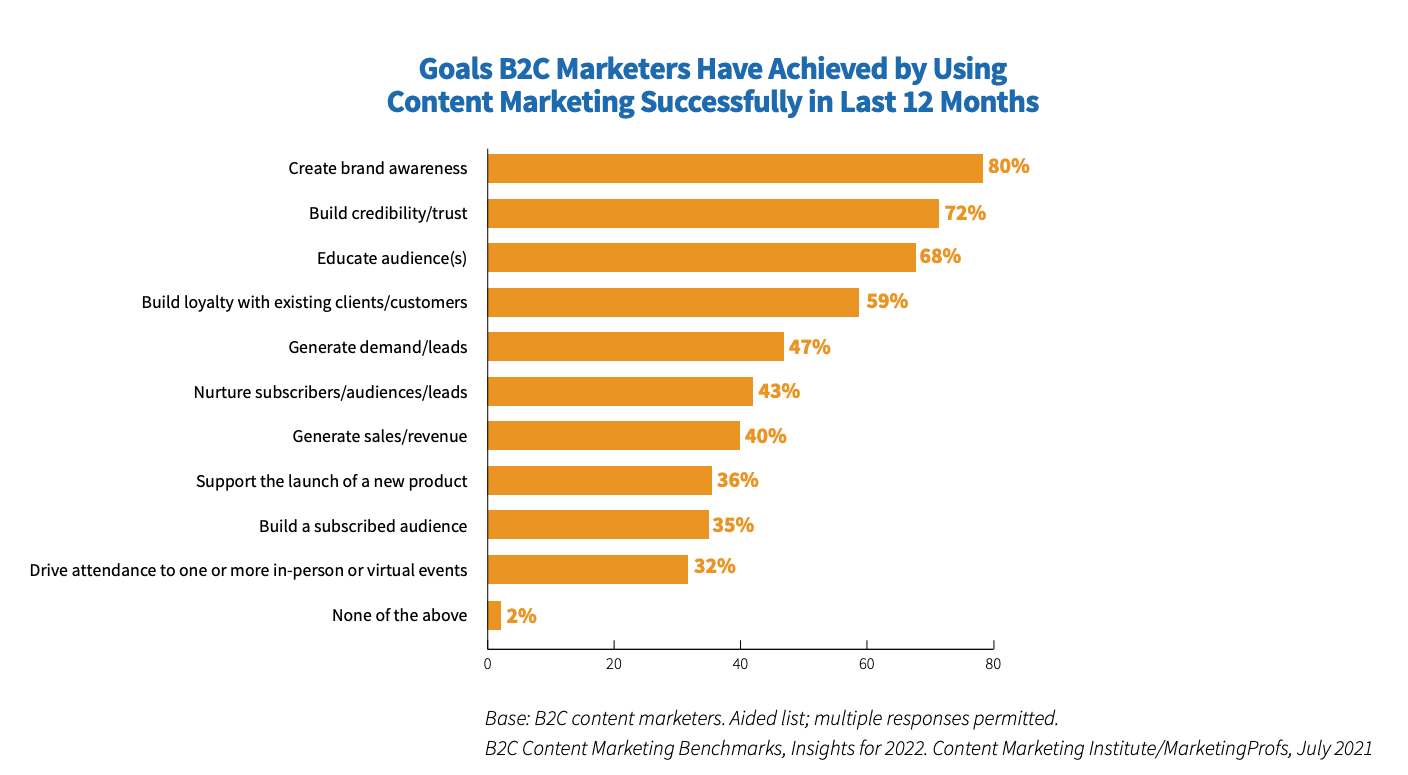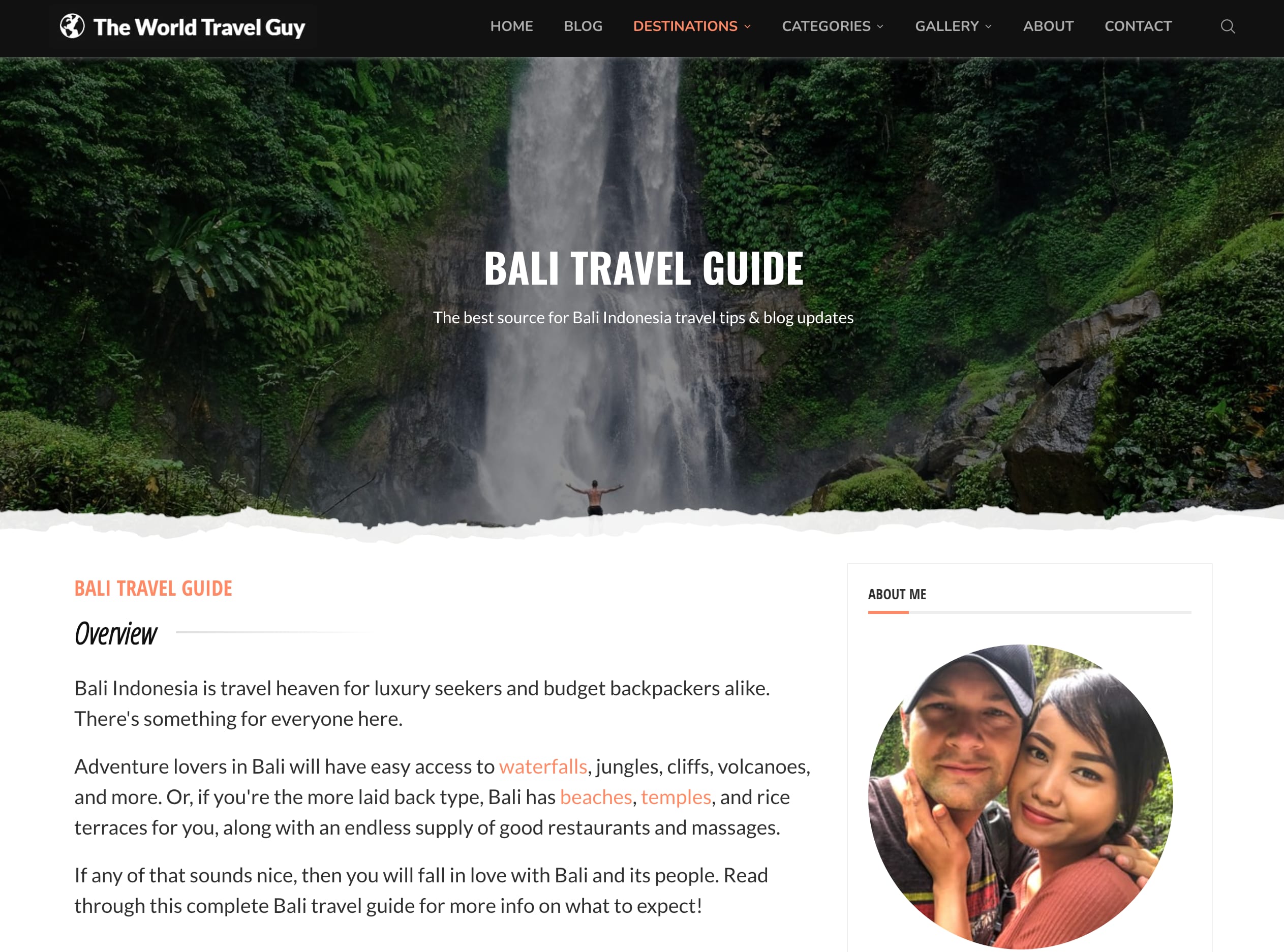What Is Content Writing? A Complete Guide
Learn how to get started with content writing, whether you’re a business owner, marketer, or freelancer.
 October 24, 2024
October 24, 2024 9 minute reading
9 minute reading
If you’re running a business, regardless of its size, chances are you can’t find the time for content writing. The thing is, content is crucial in any marketing strategy. Around 90% of marketers today adopt content in their marketing strategies—that includes content writing—to connect with audiences, build their brand identity, and boost online visibility.
Content writing goes beyond crafting written material. It lets you inform and educate your target audience, helping them see your value. The good news is that whether you’re a small business owner or entrepreneur, you can leverage content writing to leave an impact on your target audience and stand out from the competition.
This guide shows you how to get started with content writing and how effective content writing benefits businesses. It covers topics such as how to start content writing from home, the elements of effective content writing, and emerging content writing trends.
What is content writing?
Content writing is the creation of written material for digital and physical platforms, including blog posts, articles, scripts, and user guides. It encompasses researching topics, planning content strategy, writing, editing, and optimizing text for specific audiences and purposes.
Copywriting vs. content writing
Unlike copywriting that focuses on persuasive writing aimed at driving actions, such as sales or sign-ups, content writing focuses on providing valuable information or engaging content to educate or entertain an audience, often to build trust and authority.
Importance of content writing
According to a 2022 report by the Content Marketing Institute, the top three goals of B2C marketers when it comes to content marketing are creating brand awareness, building trust or credibility, and educating their audience. Effective content writing can help you achieve that and more.
When someone does an online search and visits your page, they’re there to look for answers. They want something relevant, helpful, and authentic.
As Margarita Loktionova, Content Marketing Lead at Semrush, says, “Your content should, therefore, satisfy your audience’s needs. It has to answer your reader’s doubts and offer a great user experience at the same time.”
Loktionova also explains that, “It doesn’t matter if you head up a Fortune 500 company or run a small family business—you can create content that offers real value to your audience.” In digital marketing, when you get these components right, you can drive real results, like increased website visitors and conversions.
How else can content writing benefit your brand?
Build brand authority
How people view your business is crucial. You want to be seen as a reliable expert in your field, the go-to source for questions or problems.
While effective content writing can help establish this authority, it's not a magic bullet. Building brand authority is an ongoing process that requires winning over customers with compelling, useful, and high-quality content.
To establish your authority, you need to create content that:
Offers practical solutions
Provides actionable insights
Demonstrates your expertise and experience in your field
Brand authority is key in boosting your visibility in search engine results. Google, for example, updated its quality rater guidelines. From E-A-T (Expertise, Authoritativeness, and Trustworthiness), the guidelines now have an extra "E" for "Experience." The new E-E-A-T guidelines help ensure that users get access to original, helpful, and reliable information.
With brand authority comes brand loyalty. According to the 2023 Edelman Trust Barometer, when your audience trusts you:
59% are more likely to buy from you
67% are likely to stay loyal and become brand advocates
This approach to building brand authority through content can significantly impact how your business is perceived and its long-term success.
Increase website traffic and engagement
Content creation remains a significant challenge for marketers, with 24% citing lead generation as their main hurdle. This difficulty is compounded by the emergence of AI technologies and Google's updated E-E-A-T guidelines, which have reshaped the content landscape.
Despite these challenges, content writing continues to be a powerful tool for boosting organic traffic and engagement. It offers several key benefits:
Well-crafted content enhances site navigation and satisfaction by helping users easily find useful information.
Compelling content can include effective calls to action and lead magnets, driving potential customers further into the sales funnel.
Content provides an additional channel for interacting and connecting with your audience, fostering loyalty and brand affinity.
By focusing on these aspects, you can create content that attracts visitors and converts them into valuable leads.
Support SEO efforts
When done well, search engine optimization (SEO) improves your site’s visibility, making it easier for your audience to find you.
Relevant and high-quality content gives your SEO efforts a significant boost. For example, you strategically apply keyword research and proper keyword placement to your articles. These can help drive traffic to your site by allowing search engines to easily understand what your page is about and whether or not it’s relevant to visitors.
Breaking your text into easy-to-read sections also helps with readability. Keep in mind that more people are using mobile to access content. Nearly 96% of global internet users use mobile phones to go online.
Other considerations for your content include:
Using engaging visuals to complement your content and make information easier to digest
Ensuring visitors have a great experience on your site by addressing errors, optimizing page load speeds, and using relevant internal and external links
Providing useful information not covered by your competitors to address any content gaps
Types of content writing (+ examples)
When you visit a website, you’re bound to come across several types of content writing. Each type of content serves a unique purpose. Understanding the different kinds of content writing can help you communicate your ideas and reach your target audience more effectively.
Let’s look at some content writing examples to help you better understand each type.
Blog posts
Brands use blog posts to present information, share insights, and discuss experiences. Common blog posts include listicles, how-to guides, and recipes. Some companies even publish press releases and infographics on their blog for readers to engage with.
They’re an excellent channel for building your brand authority. Blog posts allow you to showcase your expertise, tackle complex ideas, and provide actionable solutions to readers. They also support your SEO efforts because you can apply SEO best practices to blog posts.
Aside from their varying lengths, blog posts may be visual or text-heavy, depending on the topic they’re exploring. These days, blogs are normally visually rich with images and videos, like The World Travel Guy’s article below.
Social media content
Social media content takes on various forms. Each type entails some form of content writing, from short-form videos to text-based posts. For example, short-form videos still need an engaging script, while posts need captions that offer compelling summaries that invite visitors to read on.
The Fiverr LinkedIn post below offers a clear, concise message for scrollers. It also has engaging visuals of Terry Rice as the video thumbnail to catch the scroller’s eye.
Whether crafting video scripts, event descriptions, or brief updates, writers must convey key information quickly and compellingly. Effective social media content writing balances informativeness with brevity, tailoring the message to the platform and audience to maximize engagement.
Email newsletters
Email marketing newsletters let you share the latest updates about your business with subscribers.
You can also use them to share exclusive offers and invite audiences to join future events. A well-written email newsletter helps you offer more added value to subscribers. Through it, you can build your brand authority, nurture customer trust, and put your brand on top of customers’ minds.
The email below is an example of an effective newsletter. Aside from using stunning images to feature the brand’s products, the newsletter also provides subscribers with updates and helpful tips on how to care for their products.
Whitepapers and eBooks
Both are types of long-form content. Whitepapers showcase your expertise, helping position your brand as an authority on a specific topic or subject. These are great channels for providing factual information and original research.
Meanwhile, eBooks allow you to dive deeper into a specific topic. But it’s not limited to that. You can also use it to provide your audience with detailed guides or an in-depth look at your products or services.
Elements of effective content writing
Learning to implement effective content writing doesn’t happen overnight. While there’s no secret formula for writing winning content, you must consider the following elements to make your work shine.
1. Understand your audience
Great content is tailored to fit your audience's interests, needs, and pain points. It also guides your clients on their buyer's journey, helping them make informed decisions. To create content that truly resonates:
Conduct thorough audience research
Create detailed buyer personas
Analyze engagement metrics regularly
When you understand your audience more deeply, you can better determine which tone and language to use. Some audiences may respond better to formal language, such as in professional networks, while a more casual audience might prefer a conversational tone. For example:
Professional: "Our innovative solution optimizes operational efficiency."
Casual: "Our app helps you get more done in less time – pretty cool, right?"
⚡ Take action: Create one detailed buyer persona including age, job title, goals, and main challenges. Use this persona to guide your next piece of content.
2. Write attractive headlines
When did a headline last catch your attention, prompting you to read the entire article? You only have seconds to grab your audience’s attention with a headline that piques their interest.
Use the 4 U’s formula to create write captivating headlines:
Useful: Highlight a clear benefit
Urgent: Create a sense of timeliness
Unique: Offer something novel or unexpected
Ultra-specific: Include concrete details or numbers
For example, transform "Ways to Improve Your Writing" into "7 Unconventional Writing Tricks to Boost Your Traffic by 50% This Month".
3. Develop a strong voice
A strong voice helps your content stand out. It’s a reflection of your brand and personality.
What you want your writing voice to sound like will depend on your writing tone, word choices, and rhythm. These factors can make your writing voice appear powerful, passionate, conversational, or inspirational.
4. Maintain readability and flow
Readable content is easy to follow and understand. Use clear headings, bulleted lists, and an active voice to improve readability. Each paragraph should also focus on one idea to encourage continuity and ensure a smooth writing flow.
💡 Tip: Use the Hemingway Editor to check your content's readability score and simplify complex sentences. Aim for a reading level of grade 6-8 to make your content accessible to a wider audience.
5. Use an active voice
The active voice is direct and clear. It helps your audience focus on the subject and makes your sentences punchier, which is useful when you want to convey your authority and expertise in the subject.
Meanwhile, using a passive voice can make sentences confusing and harder to read. Unlike the active voice, which communicates a sense of urgency, the passive voice isn’t as engaging and may cause your readers to lose interest in what you’re trying to say.
6. Fact-check everything
Fact-checking enhances your credibility and ensures the reliability of your content. By verifying that the information you present is accurate and up-to-date, you build audience trust, maintain engagement, and avoid potential legal issues.
To fact-check written content effectively:
Identify information requiring verification.
Categorize facts (e.g., dates, names, statements).
If necessary, contact the author for access to source materials.
Assess the reliability of sources used.
By following these steps, you can maintain the integrity of your content and strengthen your relationship with your audience.
7. Add original insights
Aside from making your content stand out, using original insights makes your content more attractive to readers, especially those looking for new or non-standard information.
Adding new and helpful inputs demonstrates your expertise, which helps establish you as a thought leader in the space. And because it’s something that your audience has never seen before, it can drive engagement. This gives them a new avenue to share and discuss their ideas.
8. Proofread and edit
Your content must be polished and free of errors. It must convey your ideas. Proofreading and editing can help you with that. These are important steps to maintain not just your content’s quality and credibility but also that of your brand.
How to become a content writer from home
Content writing is a useful skill to have whether you’re selling freelance writing services or looking to make money through blogging.
Below, we’re sharing a step-by-step guide on how to start content writing from home, including the content writing tools you’ll be using and how to find the best content writing format.
1. Specialize in a niche
Having a niche narrows your focus and caters to a specific audience. But with popular niches becoming crowded, consider exploring sub-niches that align with your interests and those of your audience. Here's how to find your sub-niche:
Start with a broad niche you're passionate about.
Identify more specific categories within it.
Look for unique angles or combinations.
Evaluate if there's enough interest and if you can offer unique value.
Test your concept with sample content.
A well-chosen sub-niche lets you offer highly specific content and stand out. For example, a guide on recreating vegetable recipes from The Legend of Zelda franchise is far more distinctive than a general cooking blog.
2. Develop essential skills
Aside from strong communication and research skills, you must be adaptable to using different writing styles. For example, technical writing entails different responsibilities and outputs like business proposals or case studies. Meanwhile, copywriting is more focused on the marketing aspect.
To start, you can sign up for content writing courses. It also helps to analyze content writing examples to see the techniques the writer used and whether or not their content is effective.
3. Master different content formats
The content writing format you use will influence how you deliver your message and how your audience will react to it. Knowing how and when to use a specific content writing format makes you a versatile writer who is capable of meeting a broad spectrum of needs. Plus, your mastery can open up new growth opportunities.
By being versatile, you can better reach and engage a diverse audience. Mastery of both short- and long-form articles, for example, lets you cater to the needs and interests of audiences who prefer different content types.
4. Learn to use content writing tools
Content writing tools make your life easier, but you need to figure out which tools can help you achieve a specific goal or objective.
To get started, familiarize yourself with some key tools that address different aspects of content creation:
Semrush: Powerful platform for keyword research and competitor analysis
Grammarly: AI-powered proofreading to enhance writing quality
Trello: Visual project management to organize your content calendar
Canva: User-friendly design tool for creating visual content
While these tools are valuable, they're most effective when combined with your unique insights and creativity. Experiment with different tools to find the combination that best suits your content writing process and goals.
5. Build a portfolio
Your portfolio gives potential clients a glimpse into your capabilities. First, you want to pick a niche (or a sub-niche).
Then, create a profile on freelance marketplaces such as Fiverr to expand your reach. On Fiverr, you can set up "gigs" that highlight your specific writing skills and showcase samples of your work. This allows potential clients to easily find and hire you based on your specialties.
Here’s an example of a content writing portfolio on Fiverr. The writer showcases his samples, ratings, and past clients to convince brands he’s worth working with.

The great thing about having a writing portfolio, both on your own website and on platforms like Fiverr, is that you can update it as you gain more experience. Regularly add new, high-quality samples to demonstrate your growth and attract a wider range of clients.
By following these steps and leveraging platforms like Fiverr, you can create a strong portfolio that effectively markets your writing skills to potential clients.
6. Find content writing opportunities
Content writing websites help you find writing gigs, build experience, and earn money. They offer guest posting opportunities to grow your portfolio and connect with other professionals. These platforms can help you understand market rates and find skill-building resources.
Fiverr has recently expanded its offerings for content writers, which include:
A profession-based catalog to showcase your skills
Hourly rates for long-term projects
A kickstart program for new freelancers with guided onboarding and free courses
AI-enhanced reviews for better feedback
These features can help content writers find more opportunities and build a stronger presence in the freelance market.
7. Stay updated with industry trends
Follow industry blogs, sign up for content writing newsletters, and engage with leading figures in the content writing industry.
Aside from staying on top of trends, find content gaps that you can address. Doing so gives you a strategic advantage and helps establish your brand as an authority, given that you're writing about topics your competitors aren't discussing.
8. Develop a personal brand
Having a strong personal brand can help you stand out. With a memorable tagline, you give potential clients an idea of who you are and what you can do.
A scroll-stopping logo also comes in handy. Make captivating, professionally designed logos for your business in just a few clicks with the Fiverr Logo Maker.
9. Collaborate with other professionals
This is also a crucial step to building a strong personal brand. Plus, collaborations expand your reach while still allowing you to showcase and hone your skills as a content writer.
Some actionable steps to build your personal brand through collaborations:
Reach out via LinkedIn or professional forums with a specific collaboration idea.
Propose joint projects like co-authored articles, webinars, or podcast appearances.
Guest post on each other's blogs or newsletters to cross-promote.
Create a joint content series or eBook to showcase both parties' expertise.
Share and engage with collaborators' content regularly on social media.
By actively pursuing these collaborations, you'll expand your reach, enhance your skills, and strengthen your brand as a content writer.
💡 Tip: Join a freelance writing community like Peak Freelance to meet other writers and collaborate with them.
10. Set competitive rates
Setting competitive rates as a content writer is both an art and a science. Your journey begins with self-assessment: Are you a novice finding your footing, or a veteran with a track record of success? Your experience level is the foundation of your pricing strategy.
There are a few different pricing models to consider:
Per-word rates for straightforward projects
Hourly billing for varied tasks
Project-based fees for defined scopes
Retainer arrangements for ongoing work
Dive into industry-specific resources like the Editorial Freelancers Association's rate chart. This will give you a window into what others in your field are charging.
Start slightly below your ideal rate if needed, but don't undervalue yourself for long. As you build your portfolio and client base, gradually increase your rates.
💡 Tip: Set reminders to reassess your pricing every 6-12 months, aligning it with your growing skills and shifting market demands.
11. Manage client relationships
Building strong relationships with your clients is vital to growing your career as a content writer. You get repeat business, positive referrals, and the chance to create a healthy work environment.
Start by knowing who your client is. What do they need? What about their goals and target audience? How can your content writing services help them? You need to be flexible and adaptable so you can quickly pivot with your client’s evolving business needs or priorities.
To take things a step further, consider providing added value to your client to help you stand out from the competition. This could include providing writing-related services like content strategy or informing them about new industry trends.
Content writing tips
Mastering content writing is essential for effective digital marketing and communication. The following tips will help you create compelling, consistent, and impactful content that resonates with your audience.
Create a Voice Chart
Create a Voice Chart to define and maintain consistency in your brand voice. Include three columns:
Voice Characteristic (e.g., "Friendly")
Description (e.g., "We're approachable and welcoming")
Do's and Don'ts (e.g., "Do use casual language; Don't use slang")
Fill in 3-5 rows with key voice characteristics. Refer to this chart when creating content to ensure your voice remains consistent across all platforms and formats.
Write evergreen content
Evergreen content stays relevant for a long time. Your articles, blog posts, and guides remain valuable and interesting to your audience.
However, just because you've written evergreen content doesn't mean that you'll leave it as is. You must regularly update your content with new information, fix broken links, and use the latest, relevant keywords.
Leverage video
Video content is engaging and shareable, making complex information easier to understand. According to 45% of marketers, it's also the best-performing content type, followed by short-form articles (31%), success stories (28%), and long-form blog posts (24%).
From how-to guides to presentations, there are many ways to incorporate video into your content. For example, you can create a short video guide that lists important points from your article.
Work with talented writers
By working with content writing experts, you can leverage their specialized expertise, get new perspectives, and focus on strategic aspects of your business.
Fiverr Business helps you connect with good content writers who can help you bring your ideas to life. From blog posts to social media content, Fiverr makes it easier than ever to find professional freelance writing services who best fit your business needs.
Want to see how Fiverr’s top talents are helping transform businesses and making their content stand out? Explore impactful projects by some of our skilled freelancers.
Use a clear structure
Organize your content with a logical flow. Use headings, subheadings, bullet points, and short paragraphs to make your content scannable and easy to digest. This structure helps readers navigate through your content effortlessly.
Incorporate SEO best practices
While writing for your audience should be the priority, optimizing your content for search engines is important. Research relevant keywords, use them naturally throughout your content, and include meta descriptions and title tags.
Proofread and edit
Always review your content for grammar, spelling, and punctuation errors. Consider reading it aloud to catch awkward phrasing. If possible, have someone else review it for a fresh perspective.
Content writing trends
As mentioned earlier, content writing goes beyond crafting written material. Staying on top of emerging industry trends is also essential and can give you a strategic advantage.
AI and content creation
While there’s some skepticism surrounding the use of AI in content writing, you must remember that these AI tools won’t replace human ingenuity. It helps if you view them as tools to help you create winning content. They can also make your writing process more efficient, enabling you to deliver extraordinary results.
Embracing AI and automation opens up new opportunities for content writers. They can speed up workflows, automate repetitive tasks, and find fresh perspectives.
According to Harvard Business Review, small businesses can benefit from leveraging AI capabilities. These capabilities can help them close content, insight, or technology gaps, helping level the playing field. For example, small businesses can use generative AI tools alongside real human writers to consistently produce effective, engaging, and high-quality content.
If you want to learn more about AI tools and how they can help you with content writing, check out our guide to AI tools for social media content creation.
Need an expert content writer who can meet your evolving business needs while staying on top of AI and content creation trends? Fiverr connects you with skilled freelancers who can craft on-brand winning content for your business.
Emerging content formats
Choosing the right content writing format is key to delivering your message effectively. While "traditional" formats like social media posts, blog posts, and articles still matter, staying up-to-date with new content formats will serve you well.
Try experimenting with increasingly popular formats like multimedia and interactive content. These can make your content more dynamic and engaging, giving your target audience a more immersive experience.
Evolving SEO practices
Search trends, like content marketing trends, are always evolving. This applies to SEO practices as well. You have to factor in Google’s updated E-E-A-T guidelines, how to leverage video content for maximum engagement, and how to prioritize user experience.
While these practices and trends continue to change, one thing’s for certain—you must remain adaptable. You need to stay up to date and apply the latest SEO practices to ensure your content continues to provide value to your readers.
Hire a content writing expert on Fiverr today
With Fiverr, anything’s possible.
Fiverr lets you quickly and easily find freelancers with the skills you need to take your business to greater heights. It’s as simple as exploring content writing services on the Fiverr marketplace, reaching out to your preferred freelancers, choosing a Gig package, and receiving the deliverables.
Fiverr makes it even easier for you to find expert content writers. Features like search filters, freelancer reviews, and portfolios help make your search a breeze.
Explore Fiverr's content writing services and connect with talented writers who can bring your vision to life. Whether you need blog posts, website copy, or social media content, find the perfect content creator for your project on Fiverr today.
Interested in learning how Fiverr can help you hone your skills and grow your brand? Check out these helpful resources:
See how Fiverr Project Partners help businesses like yours
Find online professional courses to make your content writing shine
Join the Fiverr Creator Network to unlock exclusive opportunities
Content writing FAQ
What is meant by content writing?
Content writing is about writing and publishing content like articles, product descriptions, video scripts, and social media posts. Through it, you can inform and educate your audience, grow your business, and convey a specific message or idea.
What is an example of content writing?
Content writing goes beyond writing articles or blog posts, as it covers different formats, lengths, and goals. These include case studies, white papers, product guides, speeches, scripts, and web page copy.
How do I start content writing?
While there’s no one right answer to this, you can always go the DIY route by reading and writing as much as you can or taking content writing courses online. You may also consider getting an undergraduate degree that helps establish and hone your writing skills. The key here is to get as much experience as you can, continue to improve your skills, and build a strong portfolio to demonstrate your skills to potential clients.
What is the job of a content writer?
Your role isn’t just limited to writing content. As a content writer, you must also:
Optimize SEO content
Meet brand guidelines and ensure consistency
Repurpose digital content
Come up with content ideas
Perform in-depth research
Know how to adapt to industry trends











